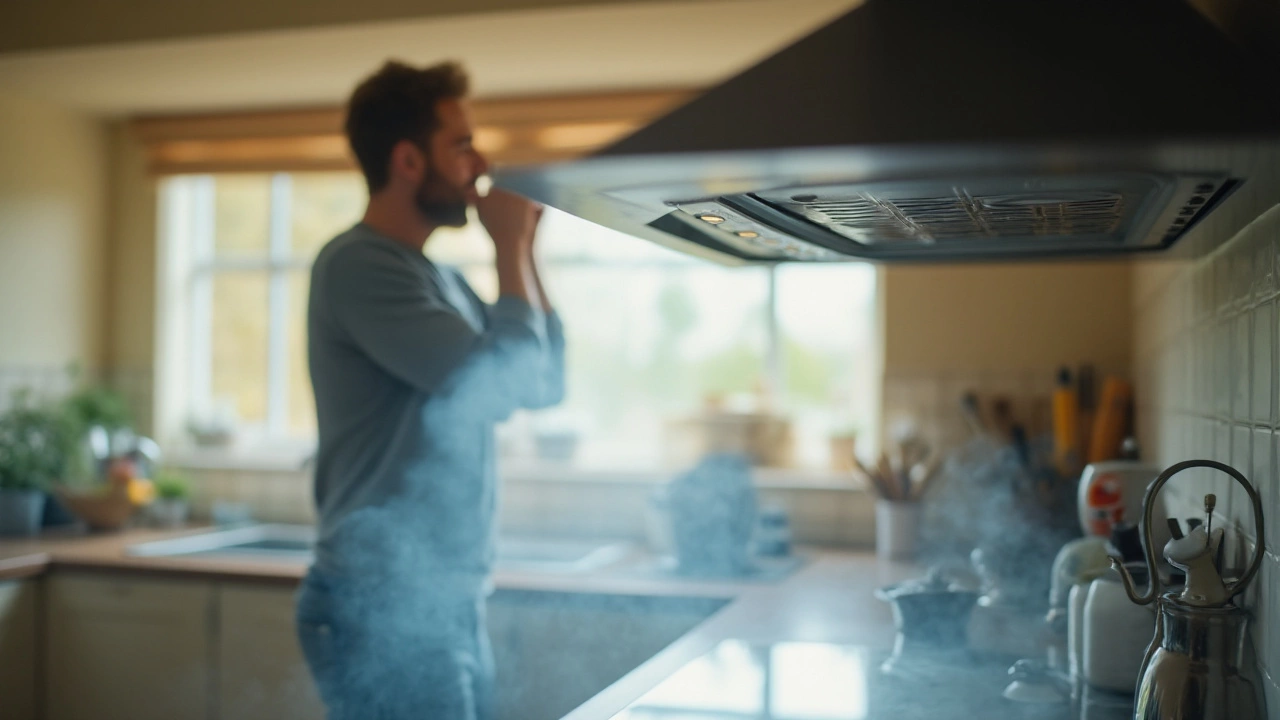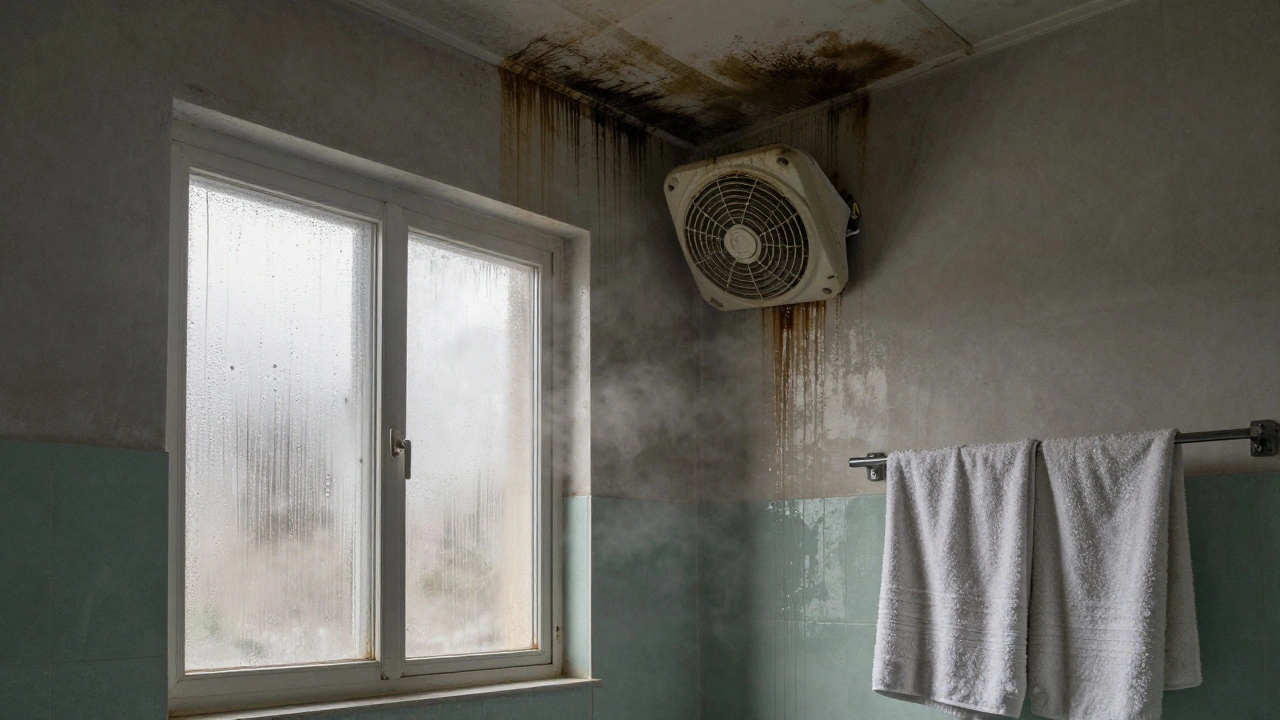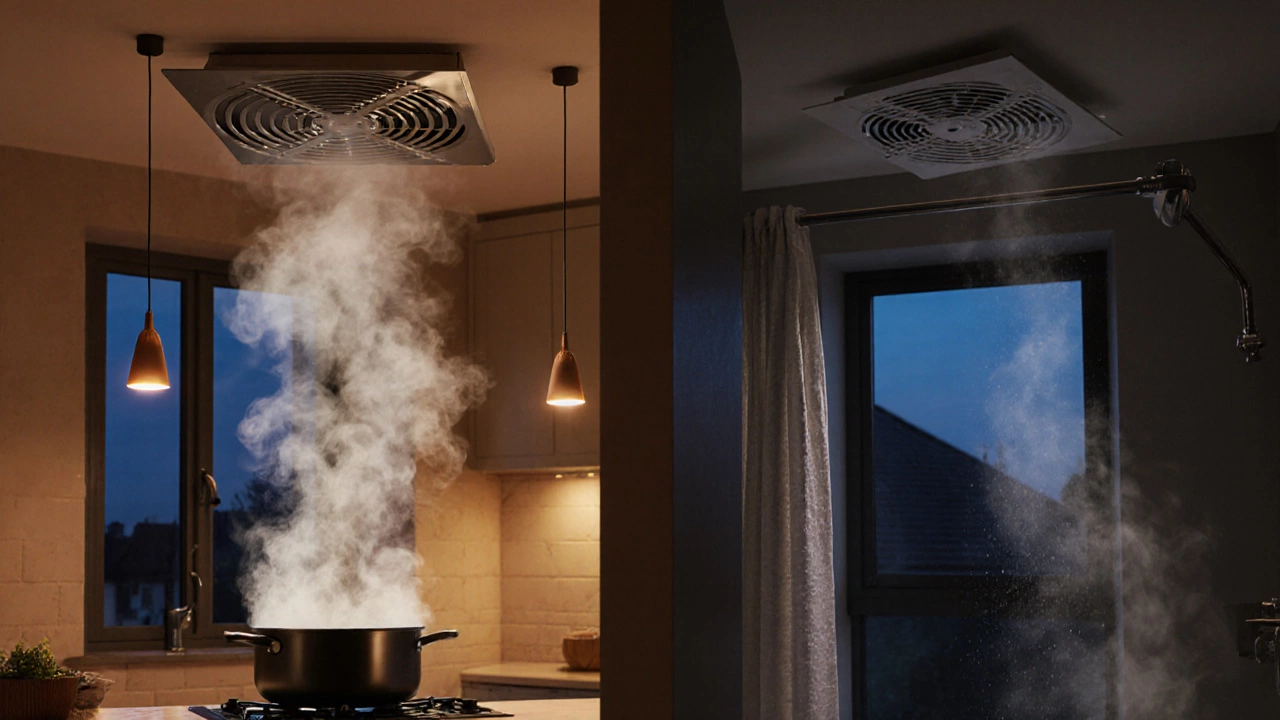
- 8 Oct 2025
- Gideon Thornton
- 0
Extractor Fan Usage Calculator
Estimated Daily Cost
£0.00
At current UK electricity rate of 34p/kWh
Ever wondered if you can just slap the extractor fan on and forget about it? Maybe you’re cooking a big dinner, the bathroom is steamy after a shower, or you just want to keep the house feeling fresh overnight. Leaving a fan running sounds simple, but the answer isn’t a straight yes or no. Below we break down the safety, cost, and health angles so you can decide what’s best for your home.
Key Takeaways
- Continuously running an extractor fan is safe if it’s well‑maintained, properly wired, and installed per UK Building Regulations.
- Energy use rises modestly - expect about 15‑30W per hour for most residential units.
- Running the fan helps control humidity, reduces mold risk, and improves indoor air quality, especially in kitchens and bathrooms.
- Potential downsides include higher electricity bills, increased wear on the motor, and a slight fire‑risk if the fan is faulty.
- Use timers, humidity sensors, or manual control to balance safety, cost, and air quality.
How an Extractor Fan Works
Extractor fan is a ventilation device that pulls moist or odorous air from a room and expels it outside through a duct. It typically consists of a motor, blades, a housing, and a switch or sensor. In the UK, most kitchen and bathroom fans are rated between 50 and 150cubic metres per hour (m³/h), enough to clear steam from a shower in a few minutes.
The fan creates a pressure differential that draws air across the room, pulling pollutants like cooking fumes, water vapor, and volatile organic compounds (VOCs) out of the living space. Proper ducting ensures the air is released safely outdoors, not back into the attic or other rooms.
Safety First: Electrical and Fire Considerations
Electrical safety is the biggest reason people hesitate to leave a fan on. Here’s what to check:
- Wiring compliance: The fan must be connected to a correctly rated circuit breaker (usually 13A in UK homes). A loose connection can cause overheating.
- Motor temperature: Quality fans have built‑in thermal protectors that shut off the motor if it exceeds safe temperatures (around 80°C).
- Fire risk: While rare, an old or dirty fan can ignite lint, grease, or dust. Cleaning the blades and ensuring the duct is clear reduces this risk dramatically.
The Building Regulations Part F covers ventilation requirements for new homes and major renovations states that any mechanically driven ventilation must meet safety standards and be installed by a qualified electrician if hard‑wired. If you’re using a plug‑in fan, make sure the socket is not overloaded with other high‑power appliances.
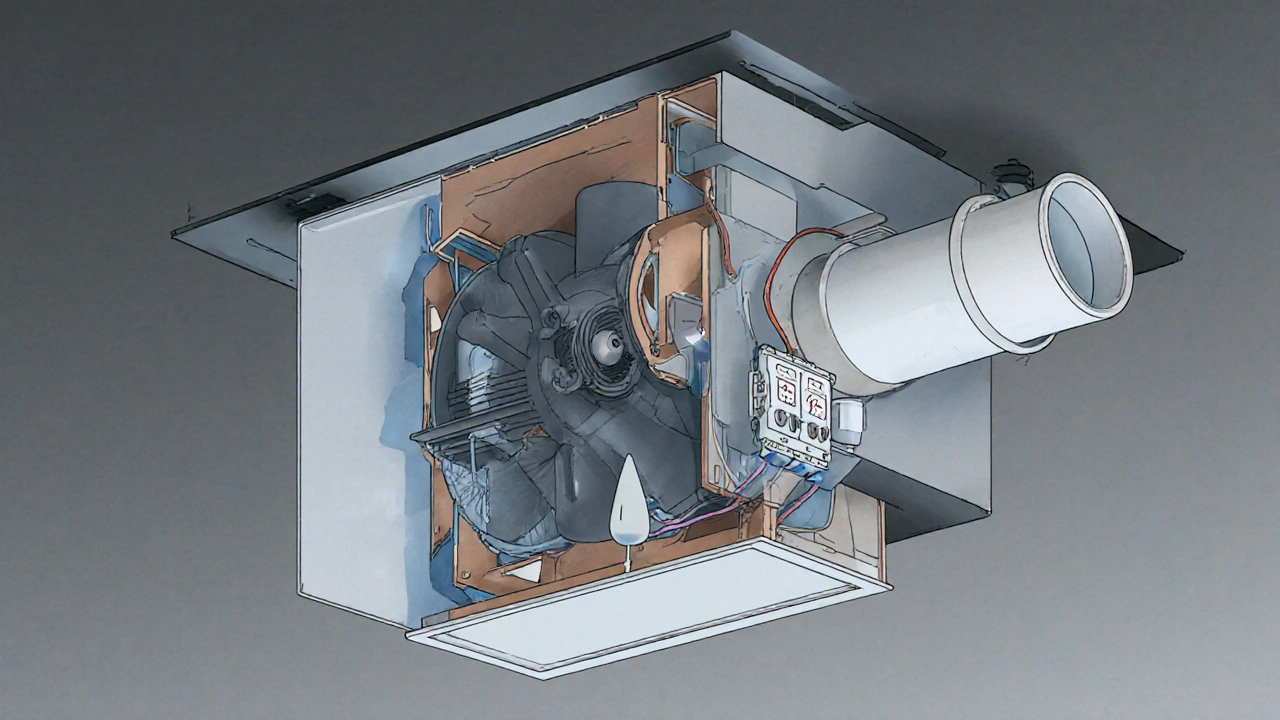
Energy Consumption and Cost Impact
Most residential extractor fans draw between 15W (low‑speed) and 30W (high‑speed). Running a 20W fan for 24hours uses 0.48kWh, which at the UK average electricity price of 34p/kWh adds about 16p to your bill each day - roughly £5 per month. Not huge, but it adds up if you have multiple fans or a high‑speed setting.
Smart controls can trim this cost. A timer that runs the fan for 30minutes after a shower uses only 0.5kWh, saving around 70% of the energy compared to continuous operation. Some modern fans include humidity sensors that automatically switch off once moisture levels drop below 60% relative humidity.
Impact on Indoor Air Quality (IAQ)
Leaving a fan on does more than just expel steam - it actively protects the health of your home:
- Moisture control: High humidity encourages mold growth on walls, ceilings, and inside cupboards. By continuously removing moisture, the fan keeps relative humidity in the 40‑60% sweet spot.
- Odor reduction: Cooking smells and bathroom odors contain VOCs that can linger and affect comfort. An active fan clears these compounds faster.
- Allergen removal: Dust mites thrive in damp environments. Better ventilation reduces dust mite populations and can ease allergy symptoms.
Studies from the UK Health and Safety Executive (HSE) show that homes with adequate ventilation have 30% fewer reports of damp‑related health issues. So, from a health perspective, leaving the fan on - especially in moisture‑rich rooms - can be a win.
Best Practices: When to Run, How Long, and What Controls to Use
- Kitchen: Turn the fan on at the start of cooking and keep it running for about 10‑15minutes after you finish. If you’re frying or using a lot of steam, consider a longer run.
- Bathroom: Activate the fan the moment you step in. A timer set for 20‑30minutes after you finish a shower is ideal. Many newer fans have built‑in humidity sensors - let them do the work.
- Nighttime or whole‑house: If you have a central extractor system, a low‑speed overnight setting can help maintain a fresh environment without noticeable noise.
- Use timers or smart plugs: Simple mechanical timers cost under £10 and are easy to install. Smart plugs let you control the fan via an app, set schedules, or integrate with voice assistants.
- Regular cleaning: Remove dust from the blades and check the duct for blockages every six months. A clean fan runs more efficiently and stays cooler.
By matching the fan’s operation to moisture‑producing activities, you get the health benefits while keeping energy use low.
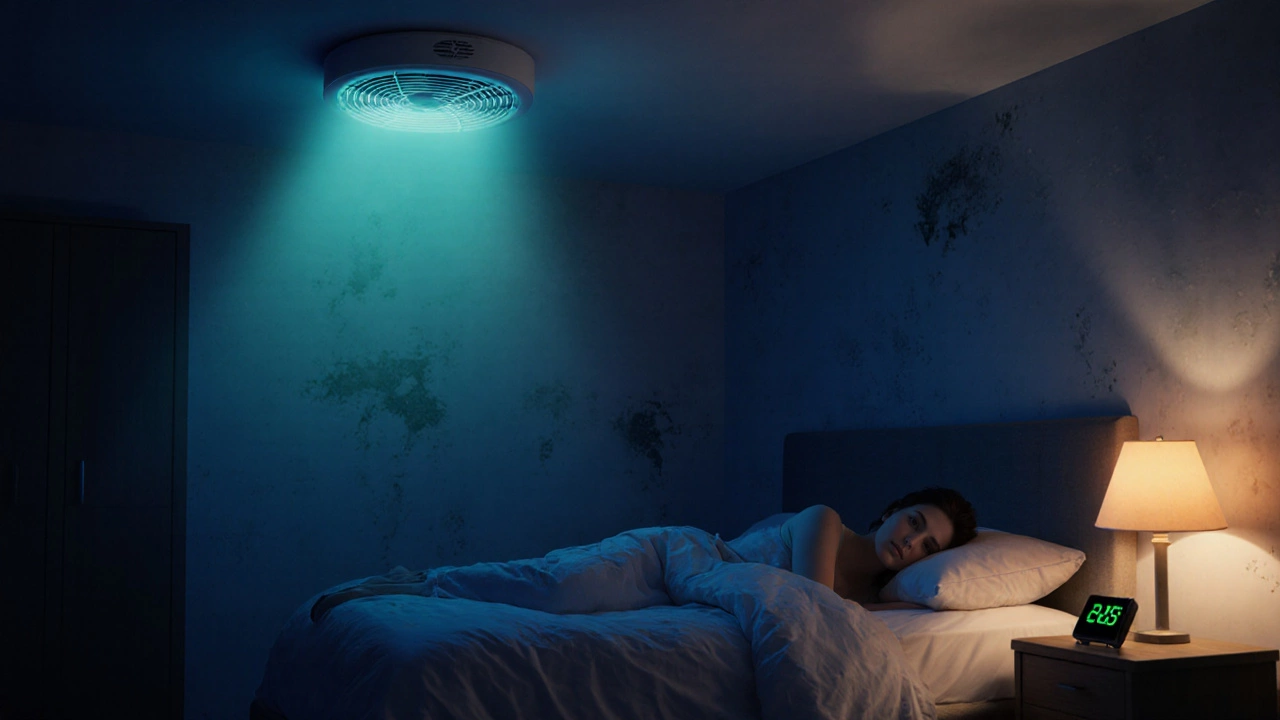
Signs the Fan Needs Attention
A well‑maintained fan can run 10‑15 years. Look out for these warning signs:
- Unusual noises: Grinding or rattling often means a loose blade or motor bearing wear.
- Reduced airflow: If steam doesn’t clear as quickly, the duct may be clogged or the fan’s motor may be weakening.
- Overheating: The fan housing feels hot to the touch after a short run - turn it off and inspect the wiring.
- Electrical flicker: Lights dimming when the fan starts could signal an overloaded circuit.
If you spot any of these issues, unplug the fan, clean it, and if the problem persists, call a qualified electrician or a specialist from our Extractor Fan Repair service.
Quick Decision Cheat‑Sheet
| Aspect | Continuous Use | Intermittent Use |
|---|---|---|
| Energy Use (per day) | ~0.48kWh (≈£0.16) | ~0.15kWh (≈£0.05) |
| Noise Level | Constant low hum | Only during operation periods |
| Motor Lifespan | Slightly reduced (10‑15% faster wear) | Longer, less thermal stress |
| Moisture Control | Excellent - maintains low humidity | Good if timed correctly |
| Fire Risk | Low if fan is clean and wired correctly | Very low |
For most households, intermittent use with a timer or sensor gives the best balance of cost, noise, and longevity.
Frequently Asked Questions
Can I leave my kitchen extractor fan on overnight?
Yes, if the fan is in good condition and wired to a dedicated circuit. Running it on low speed helps remove residual cooking odors and keeps humidity low, but using a timer can save a few pennies.
Does continuous fan use increase the risk of fire?
The risk is minimal if the fan is clean, the motor isn’t overheating, and the wiring complies with Building Regulations. Regular cleaning and checking for signs of wear are the best safeguards.
How much does an extractor fan add to my electricity bill?
A typical 20W fan running 24hours uses about 0.48kWh, which at current UK rates costs roughly 16p per day. Over a month, that’s around £5 - modest, but noticeable if you have several fans.
What’s the best way to control humidity in the bathroom?
Install a humidity‑sensor fan that automatically switches off when RH drops below 60%. If you have a manual fan, run it for 20‑30minutes after each shower or use a timer.
How often should I clean my extractor fan?
At least twice a year - once in spring and once in autumn. If you cook greasy meals often, clean the fan every three months to prevent grease buildup.


